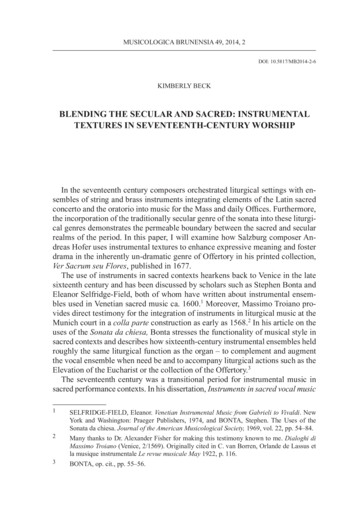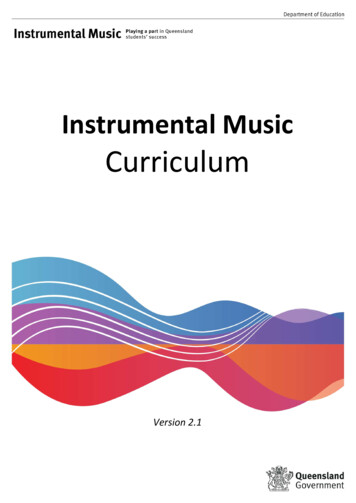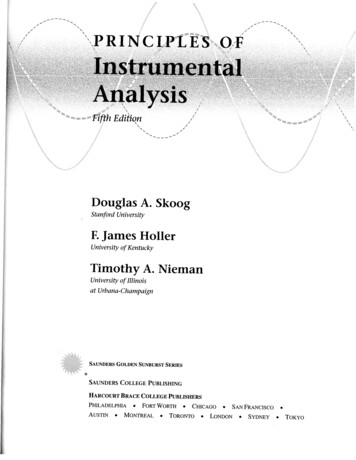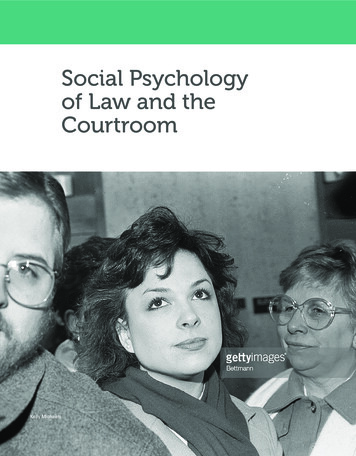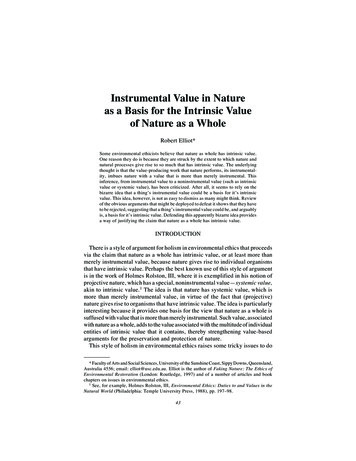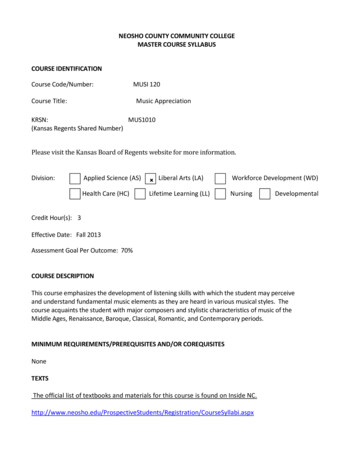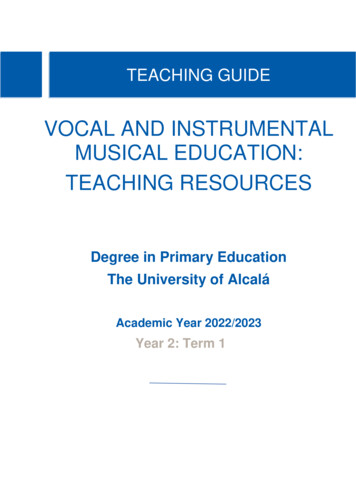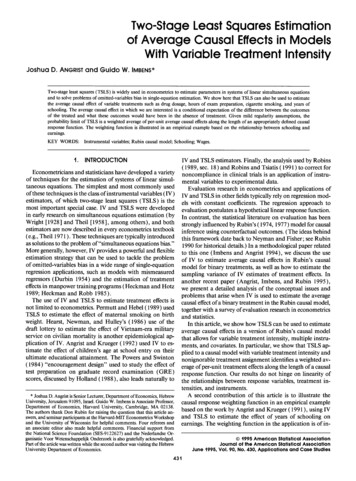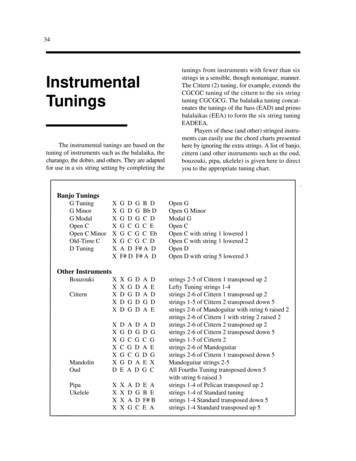
Transcription
34InstrumentalTuningsThe instrumental tunings are based on thetuning of instruments such as the balalaika, thecharango, the dobro, and others. They are adaptedfor use in a six string setting by completing thetunings from instruments with fewer than sixstrings in a sensible, though nonunique, manner.The Cittern (2) tuning, for example, extends theCGCGC tuning of the cittern to the six stringtuning CGCGCG. The balalaika tuning concatenates the tunings of the bass (EAD) and primobalalaikas (EEA) to form the six string tuningEADEEA.Players of these (and other) stringed instruments can easily use the chord charts presentedhere by ignoring the extra strings. A list of banjo,cittern (and other instruments such as the oud,bouzouki, pipa, ukelele) is given here to directyou to the appropriate tuning chart.Banjo TuningsG TuningG MinorG ModalOpen COpen C MinorOld-Time CD TuningXXXXXXXXG DG DG DG CG CG CA DF# DG B DG Bb DG C DG C EG C EbG C DF# A DF# A DOpen GOpen G MinorModal GOpen COpen C with string 1 lowered 1Open C with string 1 lowered 2Open DOpen D with string 5 lowered DADGGDGADADCADEGDGGEGXCXXXXXXXXADAGDGDCE AB EF# BE Astrings 2-5 of Cittern 1 transposed up 2Lefty Tuning strings 1-4strings 2-6 of Cittern 1 transposed up 2strings 1-5 of Cittern 2 transposed down 5strings 2-6 of Mandoguitar with string 6 raised 2strings 2-6 of Cittern 1 with string 2 raised 2strings 2-6 of Cittern 2 transposed up 2strings 2-6 of Cittern 2 transposed down 5strings 1-5 of Cittern 2strings 2-6 of Mandoguitarstrings 2-6 of Cittern 1 transposed down 5Mandoguitar strings 2-5All Fourths Tuning transposed down 5with string 6 raised 3strings 1-4 of Pelican transposed up 2strings 1-4 of Standard tuningstrings 1-4 Standard transposed down 5strings 1-4 Standard transposed up 5Other InstrumentsBouzoukiCitternMandolinOudPipaUkelele
36 Instrumental TuningsTheBalalaikaTuningThe balalaika is a three stringed Russian folkinstrument with a characteristic triangle shapedbody. The balalaika family extends from the largebass (tuned EAD) through the tenor, alto, and theprima balalaika (which is tuned EEA). The balalaikatuning concatenates the bass and prima tuningsonto one fretboard for an interesting, if not authentic, tuning.The strength of the tuning lies in its naturalkeys, E and A, and in the trance like effect of thetwo E strings tuned to the same note. Unless yourestring the guitar, the second string is very loose,which gives the tuning a "sitar" like quality.
Balalaika Tuning37
38 Instrumental TuningsTheCharangoTuningThe charango is a ten stringed instrumentfrom the Andes region of Peru and Bolivia thatoften uses an armadillo shell as a resonator. Theinstrument is typically held high up on the chestand the strings are tuned in pairs like a mandolin ora 12 string guitar. The third pair is usually tuned tooctaves, while the other four pairs are in unison.Perhaps the most striking aspect of the tuning isthat the strings do not ascend uniformly from lowto high. Rather, they jump up, down, up and up,forming an Am7 chord (with an E bass) all withinone octave. This makes for some very interestingfinger picking patterns since the bass (on string 3)tends to be syncopated against the beat.In the Andean musical tradition, the charangoserves three roles. When playing melody lines, itsdouble strings tend to give it a mandolin-likesound. In its finger picking style, it tends to soundvery "fast," playing a role analogous to a banjo inthe American folk tradition. Finally, charango players have perfected a rapid strum in which the firstfinger of the right hand flails rapidly back and forthover the strings. The loose wrist of the style isreminiscent of the rapid strumming of "spanish"style guitar, though the higher octave of thecharango gives it a unique flavor.
Charango Tuning39
40 Instrumental TuningsCitternTuning OneThe cittern is an overgrown mandolin with anextra pair of strings. They can be tuned in a varietyof open tunings, such as CFCGC, DGDAD, orGCGDG, all of which can be played using thefingerings shown here for strings 2 through 6. Toplay in DGDAD, transpose all chord names downtwo steps. To play in GCGDG, transpose down 5steps (or capo up two and five steps, respectively).There are several other popular cittern tuningswhich can be played using the Cittern 2 tuning onthe next page. The table "Cross Index of Tunings"contains a complete list and more information.
The Cittern (1) Tuning41
42 Instrumental TuningsCitternTuning TwoThe three pairs of fifths span three octaves andform a wider tuning than usual. The bass is deeperand the treble is higher. Chords tend to sound very"open," with large spacing between adjacent tones,and scales invariably require sliding up and downthe fretboard. The stretches are just too long tocomfortably play in a single position.Barring a finger across all six strings soundsa chord that is neither major nor minor, and thethree fifths tuning lends itself nicely to pieces thatare tonally ambiguous.Transposing a riff or finger pattern by anoctave is simply a matter of moving over twostrings. New fingerings for chords can be found bychanging strings. For instance, the C minor 7thchord can be fingered in numerous ways.These chord forms are all related by moving the third or fourth finger (or both) two stringsup or down. With this trick, you can formhundreds of chords from a few sample chords.Doubling some of the notes gives even morepossibilities. Can you think of others?
Chittern (2) Tuning43
44 Instrumental TuningsTheDobroTuningThe dobro is a type of guitar with a metalresonator. It is usually held horizontally on the lapand played with a metal bar that acts like a moveable fret. It is typically tuned to a G major chordthat is different from the G major chord of the OpenG tuning (DGDGBD), though the three higheststrings are identical. Consequently, the high threestrings of both tunings can be played the same.The dobro tuning offers two triplets of stringstuned an octave apart, which makes it easy tovisualize chord forms and to transpose them up anddown octaves. For instance, the three note A minorchord can be played either high or low, or the twooctaves can be combined to form a more completeversion.
Dobro Tuning45
46 Instrumental TuningsTheLeftyTuningWatch a left handed guitarist play a righthanded guitar - they play chords backwards - andfinger them strangely, too. You can simulate thisleft/right confusion by restringing your guitar fromhigh to low (or by programming a MIDI guitarcontroller). Interestingly, it doesn't take long tobecome quite proficient at left hand guitar (assuming you start out proficient at right hand guitar!),because the left/right symmetry makes many chordseasier to remember. In general, scales are moreconfusing than chords - the sound often rises whenyou expect it to fall, and falls when you think itshould rise. Many standard strums take on aninteresting character because the "alternating bass"turns into an "alternating treble."Some chords are easier to finger, like thebarred E major. Some are more difficult: try to playan E ninth at the 7th fret. There are some surprises,too, some chords that "don't exist" in the standardtuning (note the F minor at the fifth fret).Hmm, I wonder what other tunings would befun in their "lefty" versions?
Lefty Tuning47
48 Instrumental TuningsTheOvertoneTuningBuilt from the 4th through 9th partials of theharmonic series, the overtone tuning is highlycompressed - all six strings fall within little morethan a single octave. This causes some very tightchords and densely packed clusters of notes. Accordingly, the chord chart emphasizes intervallicchords such as the pandiatonic forms. Many of themajor, minor, and seventh chords have repeatingtones, which adds an interesting kind of chorus ordepth to the sound. The tuning sounds like a "soprano twelve string."
Overtone Tuning49
50 Instrumental TuningsThePentatonicTuningThe six strings of the pentatonic tuning areformed from a single octave of the pentatonicscale. The tuning is highly compressed since all sixstrings span only a single octave. Chords tend tocontain multiple copies of tones which gives anoverall impression of chorusing and depth.For those using a MIDI guitar controller, thisis an excellent opportunity to assign each string toa different sound, since then multiple tones will notbe exact copies. Then, changing the inversion orposition of the chord changes the timbre.
Pentatonic Tuning51
reminiscent of the rapid strumming of "spanish" style guitar, though the higher octave of the charango gives it a unique flavor. Charango Tuning 39. 40 Instrumental Tunings . In general, scales are more confusing than chords - the sound often rises when you expect it to fall, and falls when you think it should rise. Many standard strums take .
